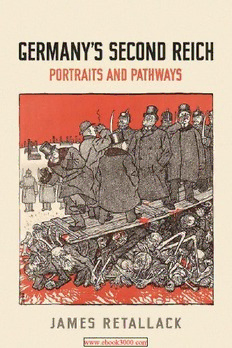
Germany’s Second Reich: Portraits and Pathways PDF
Preview Germany’s Second Reich: Portraits and Pathways
www.ebook3000.com GERMANY’S SECOND REICH Recent studies of Imperial Germany emphasize the empire’s modern and reformist qualities, but the question remains: To what extent could democracy have flourished in Germany’s stony soil? In Germany’s Second Reich, James Retallack continues his career-long inquiry into the era of Bismarck and Kaiser Wilhelm II with a wide-ranging reassess- ment of the period and its connections with past traditions and future possibilities. In this volume, Retallack reveals the complex and contradictory na- ture of the Second Reich, presenting Imperial Germany as it was seen by outsiders and insiders, and as it has been seen by historians, political scientists, and sociologists ever since. (German and European Studies) james retallack is a professor of History and German Studies at the University of Toronto. In 2015 he was awarded Research Fellow- ships from the Killam Trust and the John S. Guggenheim Memorial Foundation. His most recent book for the University of Toronto Press was The German Right, 1860–1920. GERMAN AND EUROPEAN STUDIES General Editor: Rebecca Wittmann www.ebook3000.com Germany’s Second Reich Portraits and Pathways JAMES RETALLACK UNIVERSITY OF TORONTO PRESS Toronto Buffalo London © University of Toronto Press 2015 Toronto Buffalo London www.utppublishing.com Printed in the U.S.A. ISBN 978-1-4426-5057-2 (cloth) ISBN 978-1-4426-2852-6 (paper) Printed on acid-free, 100% post-consumer recycled paper with vegetable-based inks. German and European Studies Publication cataloguing information is available from Library and Archives Canada. Cover illustrations: (front) “Durchs dunkelste Deutschland – Crimmitschau,” by Thomas Theodor Heine, Simplicissimus 8, no. 43 (19 January 1904), 337. © Estate of Thomas Theodor Heine/SODRAC (2015). The caption in Simplicissimus was “We need more policemen on top. The wretches haven’t been pressed soft yet.” (“Es müssen noch mehr Schutzleute herauf. Die Luder sind noch nicht weich gedrückt.”) Crimmitschau was the centre of Saxony’s textile industry. From 22 August 1903 to 18 January 1904 it was the site of one of Imperial Germany’s longest and most bitter strikes. Industrial employers from all parts of Germany, working with state authorities, eventually forced the striking workers to break off their action. The strikers included a large number of female textile workers. The term “Luder” has multiple connotations, some of them gendered; but they all convey Heine’s sympathy for the broken strikers. (back) This busy painting shows shopping centres and other buildings erected during the “founding era” of the early 1870s, together with bustling trams and pedestrians, all of which provide a shimmering, nervous impression of everyday life in a modern city. But we also catch glimpses of throne, altar, and state. On the left is the Hotel “Impe- rial” at König-Johann-Str. Nr. 12. Policemen mingle with well-dressed burghers. In the background two shadowy towers loom: the pinnacle of the Baroque Frauenkirche and, to its right, the squat turret atop the new police headquarters, which was erected at Schieß- gasse Nr. 8 between 1895 and 1900. Pirnaischer Platz. Vor 1914, by Ernst Richard Dietze. Städtische Galerie Dresden – Kunstsammlung, Museen der Stadt Dresden, Photograph: Franz Zadnicek. University of Toronto Press acknowledges the financial assistance to its publishing program of the Canada Council for the Arts and the Ontario Arts Council, an agency of the Government of Ontario. University of Toronto Press acknowledges the financial support of the Government of Canada through the Canada Book Fund for its publishing activities. www.ebook3000.com This book is dedicated, with love, to Stuart Adler Graham Retallack and Hanna Elizabeth Graham Retallack This page intentionally left blank www.ebook3000.com Contents List of Maps and Figures ix Preface: The Kaleidoscope of German History xi Pan 1 Forging an Empire: Economy, Society, Culture, and Politics, 1866–1890 3 2 British Views of Germany, 1815–1914 44 3 Digital History Anthologies on the Web 86 Focus 4 King Johann of Saxony and the German Civil War of 1866 107 5 Julian Hawthorne’s Saxon Studies 138 6 Bismarck and Engels: The Role of Force in History 186 7 Heydebrand and Westarp: Leaving Behind the Second Reich 202 Twist 8 Get Out the Vote! Electioneering without Democracy 237 9 The Authoritarian State and the Political Mass Market 258 10 Society and Democracy in Germany: Why Dahrendorf Still Matters 280 11 Democracy in Disappearing Ink: Suffrage Robbery as Coup d’État 293 viii Contents Acknowledgments 325 Index 333 www.ebook3000.com Maps and Figures Maps 1 The German Empire, 1871–1918 xvi © James Retallack/German Historical Institute, Washington, DC. Cartography by Mapping Solutions, Alaska Readers may also wish to consult maps in the German History in Documents and Images project, available online on the website of the German Historical Institute, Washington, DC. These include: 2 Central Europe (1815–1866) http://germanhistorydocs.ghi-dc.org/map.cfm?map_id=373 3 Creation of the German Empire (1866–1871) http://germanhistorydocs.ghi-dc.org/map.cfm?map_id=374 4 Germany and Europe in the First World War (1914–1918) http://germanhistorydocs.ghi-dc.org/map.cfm?map_id=2177 Figures 1.1 Krupp’s Steelworks in Essen, 1890 9 1.2 Wedding Photograph 13 1.3 Gottlieb Daimler’s First Automobile, 1886 31 2.1 “Prize Question,” Simplicissimus, 1911 59 2.2 “Diplomatic Training,” Simplicissimus, 1903 67
